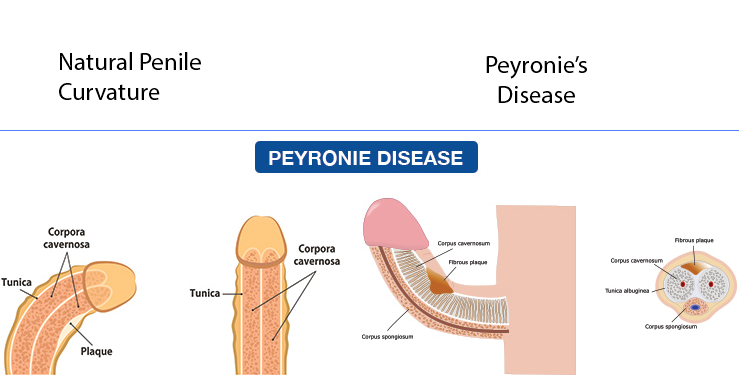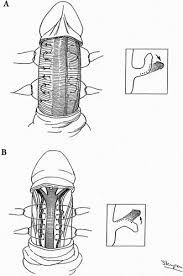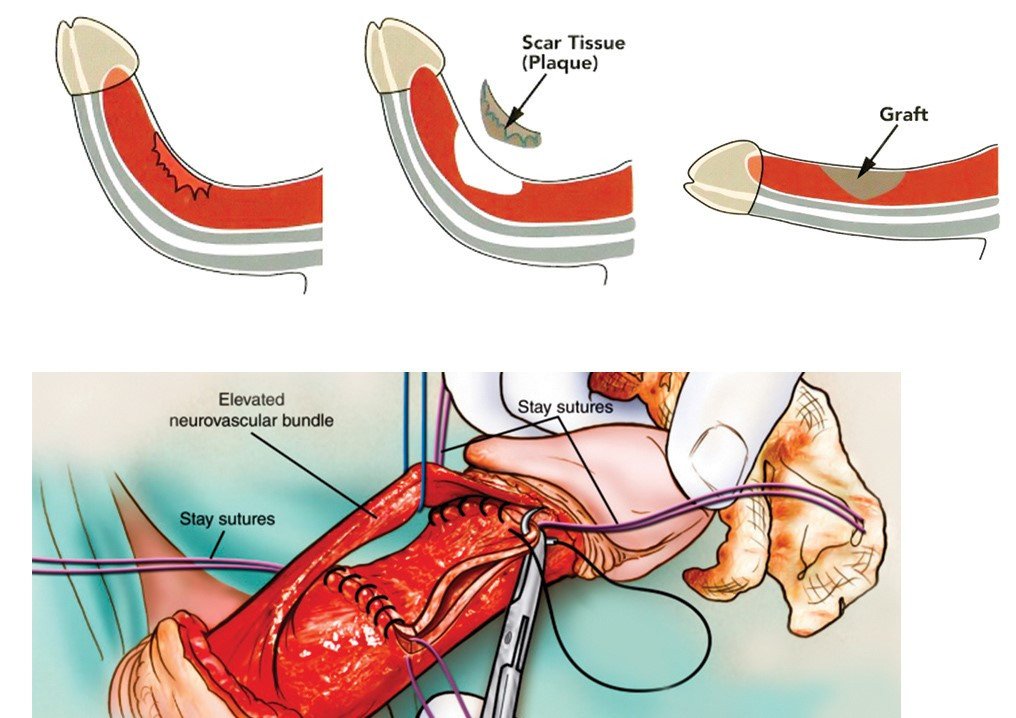
Is Peyronie’s Disease Common?
Yes, Peyronie’s disease is a very common condition. 15% of the population in the world suffers from Peyronie’s disease or bent or curved penis. The main reason why patients are not aware of this problem is that not many people talk about it. If you go to a bar, you will talk about your girlfriends, your gym, bodybuilding, or movies, but nobody will tell their friends that their penis is curved!
What is Peyronie’s Disease?
In Peyronie’s disease, the normal penile tissue is replaced by fibrous scar tissue. Because of this, when we feel the penis, there is a stony hard area over the penis, like a nodule.
What Are the Symptoms of Peyronie’s Disease?
Normally, the penile tissue is very elastic and expands well at the time of erection. In Peyronie’s disease, the normal elastic tissue is replaced by fibrous scar tissue, leading to the following symptoms:
- A hard nodule is felt over the penis
- Pain during erection
- Curved or bent penis because the penis does not expand uniformly
- Difficulty in achieving an erection and suffering from erectile dysfunction
What is the Normal Penile Curvature?
The normal penile curvature is less than 20°. If the penis bend is less than 20°, there is no problem in having intercourse. If the penis curve is more than 20°, then there can be difficulty in penetration during intercourse or the patient may have pain, making intercourse uncomfortable for both partners. If there is penile curvature, patients may also suffer from psychological trauma, because the penis shape does not look good.
What is Congenital Penile Curvature?
In some young patients, the penis is curved naturally, i.e., from birth. These patients do not suffer from Peyronie’s disease, but they suffer from congenital penile curvature (CPC). These patients will have a curved penis with a curvature ranging from 10° to as much as 80 to 90°, but they do not have any nodule of the Peyronie’s disease (Peyronie’s plaque).
So, patients with congenital penile curvature often suffer from a curved or bent penis with pain during intercourse or erection. They do not have a hard nodule and usually do not suffer from erectile dysfunction.

How Does Peyronie’s Disease Happen?
The main cause of Peyronie’s disease is micro-trauma to the penis. When there is minor repeated trauma, it leads to minor bleeding. Under normal circumstances, this blood clots, and the wound heals. However, in some people, there is an abnormal collagen in the body (type III collagen), which causes excessive fibrosis during healing. This leads to the formation of hard fibrous nodule or Peyronie’s plaque.
The Peyronie’s plaque forms in the tunica albuginea layer of the penis. The elastic tissue of the tunica albuginea is replaced by the fibrous plaque. Normally, when an erection happens, the tunica albuginea expands uniformly in all directions to give a straight and hard erection. But in Peyronie’s disease, the elastic tunica albuginea is replaced by fibrous tissue in some areas. When erections take place, the penis does not expand uniformly, leading to a bent or curved penis, painful erections, pain during intercourse, or in severe cases, erectile dysfunction.
What Are the Causes of Peyronie’s Disease?
- Excessive masturbation or rigorous sexual intercourse
- Shockwave therapy for erection or penile injections
- Prolonged catheterization or urological procedures: Prolonged catheterization can cause pressure in the urethra, which starts an inflammatory reaction, leading to abnormal wound healing and Peyronie’s disease formation.
- Prostate cancer surgery: During radical prostatectomy, a vein on the prostate known as the deep dorsal vein is ligated to reduce bleeding. It is believed that the back pressure from the blocked vein causes acute inflammatory response and the development of Peyronie’s plaques.
- Diabetes: Diabetic microangiopathy can cause urethritis and corporeal inflammation, leading to the development of Peyronie’s plaques.
- Dupuytren's contracture: People suffering from this condition have a disorder of collagen formation.
How is Peyronie’s Disease Diagnosed?
- History of curved or bent penis at the time of erection
- Physical examination: The hard fibrous plaque is formed and is palpable on physical examination.
- X-Ray of the penis: Peyronie’s plaque is identified.
- Penile Doppler Ultrasound Test:
This test helps identify the fibrous calcified plaque and assess the blood supply to the penis. If a person suffers from Peyronie’s disease and erectile dysfunction, this test can determine if there is any problem with blood circulation in the penis.
Is Peyronie’s Disease Permanent?
Peyronie’s disease progresses through two stages:
1. Acute Stage:
This occurs in the initial 6 to 12 months of the disease. The patient may start to feel a small plaque which gradually increases, or the patient may start to experience pain in the penis or a bend. During this phase, medications are given to reduce inflammation and pain. There is no role for surgical treatment in the first 6 to 12 months. During this first 6 to 12 months, the plaque may increase in size, remain stable, or reduce in size. Studies have shown that most people with Peyronie’s disease persist. Spontaneous resolution of the plaque happens in only 3 to 13% of cases. After the acute phase, the disease enters the chronic phase.
2. Chronic Stage:
After one year, the pain resolves, and the disease enters the chronic phase. Whatever the residual disease in the chronic phase, in terms of the size of the plaque or the bend in the penis, it stays stable. In the chronic phase, usually, the plaque or deformity will not increase in size, though it may or may not reduce in size. Since there is no pain during this phase, many patients do not mind the plaque or the bend. However, in some cases, the plaque may be very large, the bend may be severe, or the patient may have erectile dysfunction. In these cases, treatment will be required.
Is Peyronie’s Disease Curable?
1. Medical Treatment for Peyronie’s Disease:
- Potaba: Blocks inflammation
- Colchicine
- PDE5 inhibitors (like Viagra and Cialis): These medicines improve blood supply to the penis, assist with erections, and reduce inflammation.
- L-arginine: An amino acid that releases nitric oxide, improving blood supply to the penis and reducing inflammation.
- Vitamin E: Reduces inflammation
- Pentoxifylline: Inhibits new scar tissue formation in the penis.
None of these medicines are USFDA-approved for the treatment of Peyronie’s disease.
2. Intra-lesional Therapy (Injecting medicine directly into the plaque):
- Verapamil: A calcium channel blocker that theoretically softens the plaque, but it has not been found to be very effective. It is not USFDA-approved for treatment of Peyronie’s disease.
- Interferon: An anti-viral agent with anti-inflammatory properties. It is a painful injection and can cause flu-like symptoms, but it is not USFDA-approved for treatment of Peyronie’s disease.
- Collagenase (Xiaflex): The only agent that is USFDA-approved for treatment of Peyronie’s disease. It is currently not available in India. This enzyme is derived from bacteria and is supposed to dissolve collagen when injected directly into the plaque.
3. Surgical Treatment of Peyronie’s Disease:
Indications for Surgery in Peyronie’s Disease:
- Penile curvature or bent penis greater than 20° causing difficulty during intercourse.
- Erectile dysfunction not responding to medicines.
Types of Surgery in Peyronie’s Disease:
-
Plication: This surgery is done for patients with Peyronie’s disease without erectile dysfunction or congenital penile curvature. The procedure involves degloving the penis, creating an artificial erection, and placing sutures at the maximum curvature to straighten the penis.
-
Plaque Excision and Grafting: If there is extensive Peyronie’s plaque, it is excised, and a graft of tissue is placed to fill up the exposed area of the tunica albuginea tissue. Grafting materials include human pericardium, porcine small intestine, or the patient’s own tissue (temporalis fascia, buccal mucosa). Problems with plaque excision and grafting include potential damage to the neurovascular bundle, reduced blood supply, and decreased elasticity of the grafted tissue, which can impact erectile function.
-
Penile Implant and Modelling: This is the best treatment if Peyronie’s disease is accompanied by erectile dysfunction and a bent penis. The penile implant addresses erectile dysfunction, while modelling straightens the bent penis.
Can Peyronie’s Disease Be Cured Naturally?
The key to treating Peyronie’s disease is maintaining healthy blood flow to the penis. This can be achieved by:
- Reducing cholesterol
- Maintaining blood pressure
- Keeping diabetes under control
- Not smoking
- Exercising regularly
Frequently asked questions
[details open Should I Get Operated When There is Pain in Peyronie’s Disease?
The presence of pain indicates the acute phase of the disease. During this phase, the only treatment is through medications. Surgery is not recommended during the acute phase. ]
[details open At What Degree of Curvature Should I Operate?
Penile curvature causes both physical and psychological issues.
- Physically: If the curvature is more than 20° and the patient has pain during intercourse or is unable to perform intercourse, surgery should be considered.
- Psychologically: If the patient is troubled by the appearance of the bent penis, surgery can help straighten it.
]
[details open Is Peyronie’s Disease a Deadly Condition?
No, Peyronie’s disease is not a deadly condition.
- Spontaneous resolution of the plaque occurs in 3 to 13% of cases.
- 80% of patients do not need any treatment.
- Surgery is required in only 10% of patients who suffer from severe disease, causing significant bending or erectile dysfunction that affects intercourse.
]
[details open Why Choose Genesis Superspeciality Hospital for the Treatment of Curved Penis (Peyronie’s Disease)?
Genesis Superspeciality Hospital always prioritizes patient safety, comfort, and satisfaction throughout the treatment process. Dr. Raju R has an outstanding track record of achieving successful results and has substantial expertise in treating Peyronie’s disease.
- Exceptional surgical outcomes
- Competitive pricing
- Prompt surgical scheduling with minimized wait times
]
Dr. Raju R is an exceptional and highly skilled genitourinary surgeon (urologist) and andrologist whose capabilities in the operating room are truly commendable. Dr Raju R did his MBBS from Mysore Medical college and Research Institute (MMCRI), and he completed his M.Ch in Urology from Vijaynagara Institute of Medical Sciences (VIMS) Karnataka. Known for his scrupulous attention to detail, Dr Raju R with 13+ years of experience approaches each surgical case with a thorough understanding of the patient’s unique needs and tailors his approach accordingly.
Dr Raju R has completed 5000+ Urology and Andrology Surgeries. Beyond his surgical skills, Dr Raju fosters a sense of trust and reassurance among his patients. His clear communication, both pre-and post-surgery, helps the patient feel informed and at ease throughout their medical journey. Dr Raju’s commitment to patient-centred care contributes to a positive overall experience for those under his supervision.


 This test helps identify the fibrous calcified plaque and assess the blood supply to the penis. If a person suffers from Peyronie’s disease and erectile dysfunction, this test can determine if there is any problem with blood circulation in the penis.
This test helps identify the fibrous calcified plaque and assess the blood supply to the penis. If a person suffers from Peyronie’s disease and erectile dysfunction, this test can determine if there is any problem with blood circulation in the penis.



